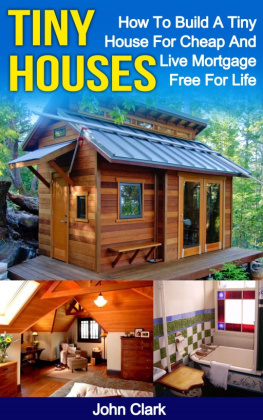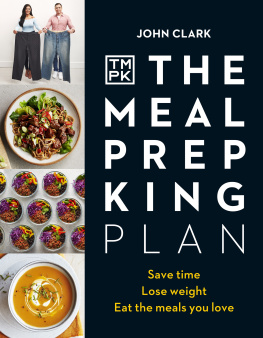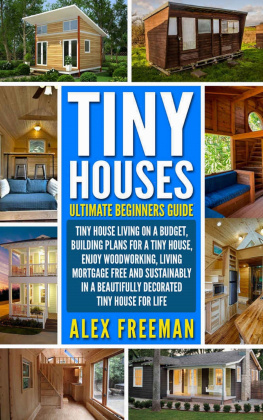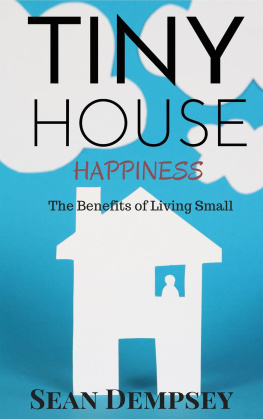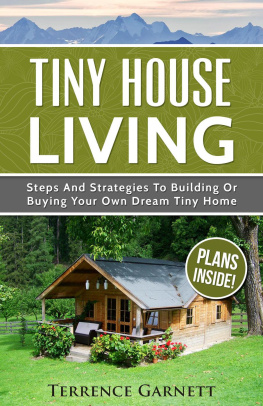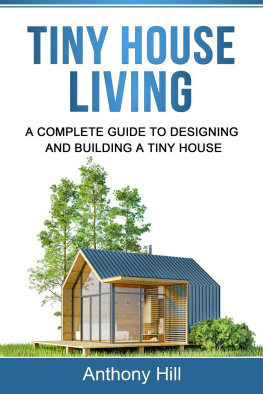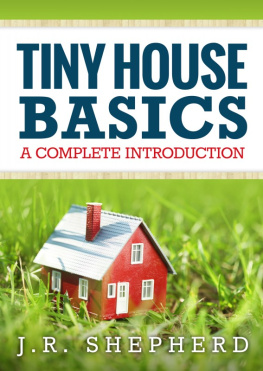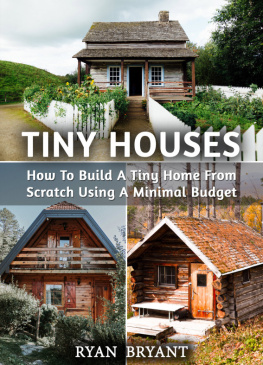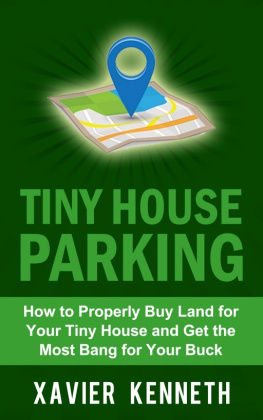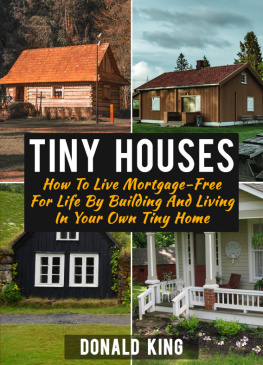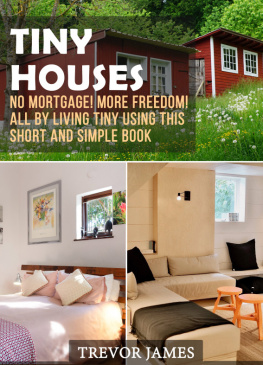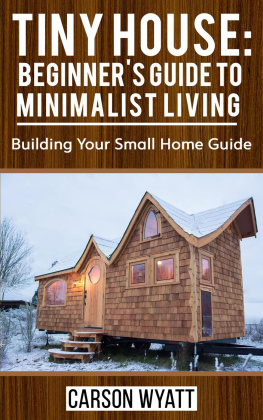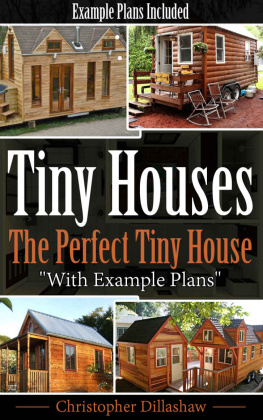Tiny Houses
How To Build A TinyHouse For Cheap And Live Mortgage-Free For Life
Introduction
I want to thank you andcongratulate you for downloading the book, Tiny Houses: How To Build A TinyHouse For Cheap And Live Mortgage-Free For Life .
This book containsinformation on how to build your very own tiny house in order tolive debt-free.
The goal of this book isto help readers make the house of their dreams on a budget. Gettingyour very own house can be something very exciting, but themortgage that comes with it can take a very heavy toll in yourfinancial, mental, and emotional health in the long run.
Now, with the help of thisbook, you can have a great house without the baggage of mortgage.With tiny houses, you can be mortgage-free for life!
Thanks again fordownloading this book, I hope you enjoy it!
Copyright 2015 by JohnClark - All rights reserved.
This document is geared towards providingexact and reliable information in regards to the topic and issuecovered. The publication is sold with the idea that the publisheris not required to render accounting, officially permitted, orotherwise, qualified services. If advice is necessary, legal orprofessional, a practiced individual in the profession should beordered.
- From a Declaration of Principles which wasaccepted and approved equally by a Committee of the American BarAssociation and a Committee of Publishers and Associations.
In no way is it legal to reproduce,duplicate, or transmit any part of this document in eitherelectronic means or in printed format. Recording of thispublication is strictly prohibited and any storage of this documentis not allowed unless with written permission from the publisher.All rights reserved.
The information provided herein is stated tobe truthful and consistent, in that any liability, in terms ofinattention or otherwise, by any usage or abuse of any policies,processes, or directions contained within is the solitary and utterresponsibility of the recipient reader. Under no circumstances willany legal responsibility or blame be held against the publisher forany reparation, damages, or monetary loss due to the informationherein, either directly or indirectly.
Respective authors own all copyrights notheld by the publisher.
The information herein is offered forinformational purposes solely, and is universal as so. Thepresentation of the information is without contract or any type ofguarantee assurance.
The trademarks that are used are without anyconsent, and the publication of the trademark is without permissionor backing by the trademark owner. All trademarks and brands withinthis book are for clarifying purposes only and are the owned by theowners themselves, not affiliated with this document.
Chapter 1 What Is ATiny House?
Tiny houses have beenaround for a long time. In fact, cavemen didnt have big houses.They had to do what they could and lived in caves in order tosurvive. So, why is there suddenly such a need to build biggerhouses? Most people only want to get big houses in order to showoff to others that they are well-to-do in life.
Though a big house canseem really great at first, the monthly mortgage payments will soonmake you think twice about your decision. This is the main reasonthat a lot of people today are getting into the tiny housemovement. Instead of the usual 3,000-ft. home, most tiny homes arevery functional even if they are only around 300 feet.
Tiny homes are veryadvantageous for homeowners because they dont come with a hugeamount of mortgage that needs to be paid off monthly. Initially, atiny house may seem expensive because you will need to shell outyour building expenses using cash. But if you consider the mortgageyou will need to pay for a certain number of years, you willdefinitely be able to save a whole lot more money from a tinyhouse.
Here are just some of theadvantages you can get out of living in a tiny house:
a. No BigMortgage
Most tiny homes arefinanced in cash. But just in case you dont have cash lying aroundto initially invest in your tiny home, you can also opt to take outa loan. The great thing about tiny homes, however, is that you willnot need a huge sum of money. The expenses related to a 300-ft.home will definitely be smaller compared to the expenses inbuilding a 3,000-ft. home. So, even if you opted to get a loan, youwill not need to pay a huge amount of mortgage in thefuture.
b. MaximumFunctionality
Most owners ofnormal-sized houses dont really utilize all of the availablespaces in their homes. Some rooms dont even get used to their fullpotential and often end up as some sort of storage room. If you owna tiny house, you will be conscious of your space and the need tomake every nook and cranny functional. Even a corner will give youso many benefits when you live in a tiny house. Hence, a tiny housecan be more functional than a regular-sized house.
c.Environment-Friendly
The goal of the tiny housemovement is to decrease mortgage costs as well as other livingcosts like utility bills. Most tiny homes can generate power todecrease electricity bills as well as capture water in order tolessen water bills. Doing this not only lessens your carbonfootprint but also makes living a whole lot cheaper than before.With tiny homes, you dont only save; you also get a chance to helppreserve and protect Mother Earth.
d. Easy Upkeep
Obviously, tiny homes arejust a fraction of the size of normal homes. There will be noproblems regarding costly upkeep. You can easily clean out everycorner of your home in a relatively shorter amount oftime.
Though the tiny housemovement is very common for the younger generation, there are alsoa number of people who went to get their tiny homes afterretirement. If you want simple living, this book can help youachieve just that! The next chapter will help you start buildingyour tiny home today!
Chapter 2 What Tools DoI Need To Build A Tiny House?
In order to build yourtiny house, you will need to have some tools ready. Of course, youcan still opt to hire a contractor to do the job. But if you wantto save up on building costs, doing the labor yourself is the onlyoption for you to be able to cut down on labor and otherconstruction costs.
Some of the tools you willneed include drills, impact drivers (which is a better optionbecause it can drive in screws faster than conventionalscrewdrivers), clamps, saws, staple guns, and other small handtools like screwdrivers, chisels, snap lines, tape measures, andwrenches.
If you are into DIYalready, you will surely have everything you need to start yourtiny home right away. But in case this is the first time you haveplanned on doing some building by yourself, then you will stillneed to get the abovementioned tools before you can start with yourproject. Take note, however, that you dont need to buy new toolsfor this. You can always borrow from a friend if you need aspecific tool for a specific task.
These tools will not beused for all your projects. Some tools are good for building likenails and hammers while others have different functions. So, youwill not need to get all of these at once. However, it is handy ifyou already have them available just remember that you can alsosimply borrow or get a certain tool only when it is actuallyneeded.
To help you out on whattools you can focus on getting first, here is a quicklist:
a. Air compressor Thisis very important throughout the job and can cost up to $150 ifbought brand-new.
b. Staple Guns and FinishNailers These tools can help you finish your job faster becauseusing conventional hammers can be very time-consuming and downrightexhausting. If you want to buy it brand-new, these tools can costaround $120.
c. Saw This is, ofcourse, important especially in building your homes frames. Onaverage, a skill miter saw can cost around $80.
Next page
